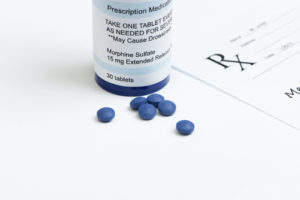Morphine is one of the oldest and most common medicinal pain relievers in the United States. It’s a naturally occurring psychoactive chemical, and its history as a medicine dates back to the 1520s and possibly as far back as the Byzantine empire. Over the centuries, it’s been used as a painkiller and for its other medicinal effects, and it’s also been used a recreational drug. Today, morphine is still used as a common prescription pain reliever despite dozens of synthetic alternatives. However, as famous as morphine is for its painkilling power, it’s notorious as an addictive substance.
The drug has a high addiction liability, and prolonged or heavy use can lead to chemical dependence and a severe opioid use disorder. Morphine addiction is notoriously difficult to overcome, and the use of prescription painkillers has often lead to the use of harder illicit drugs. However, morphine addiction is treatable with the right help and evidence-based treatment approaches.
Learning more about the signs and symptoms of addiction can help you avoid a serious substance use disorder and the consequences that come with it. Learning about morphine addiction treatment can help you get the help you need to achieve long lasting sobriety if you have developed a substance use disorder.
What Is Morphine?
Morphine is a naturally occurring opiate that’s derived from opium poppy plants and found in other plants and animals. Morphine works in the human brain by binding to opioid receptors in the nervous system. Humans have a naturally occurring opioid called endorphins that are designed to regulate and manage pain all over the body. Endorphins are so similar to medicinal opioids that they get their name from a combination of “endogenous” and “morphine.”
Morphine is more powerful than your body’s own endorphins so moderate-to-severe pain symptoms can be effectively alleviated with this medication. When morphine binds with receptors in your brain, it triggers a reaction that blocks pain signals. Normally, pain travels from the sight of damage or trauma to the spine and then to the brain. When opioid receptors are activated, it blocks your nerve cells from sending and receiving pain signal at every point on the pain path.
Though morphine is an effective medicinal painkiller, it’s also highly addictive because of the drug’s effects on the brain’s reward center. Your brain is designed to identify things that make you feel good and encourage you to repeat them. That you crave food and comfort helps you survive. However, drugs like morphine mimic the effects that food and comfort have on the brain; only it’s much more powerful. When using morphine excessively, your brain learns to encourage you to use it again. The response is so powerful that it can become a compulsion that gets out of control.
Signs and Symptoms of Morphine Addiction

Addiction is a serious disease, but learning to recognize the signs can help you avoid some of the most severe consequences of the disease. Since addiction is considered a severe substance use disorder, it often comes after some noticeable symptoms.
The first sign of a substance use disorder is a growing tolerance to the morphine you’re using. As your brain gets used to the drug, your standard dose may seem less effective than it used to be. If you continue to use, or start compensating for tolerance by increasing your dose, you may begin to become chemically dependent. Dependence is often marked by a feeling that you need to use morphine to feel normal. It may not be for the purpose of pain management or even recreation, once you become dependent. If you stop using, you may start to feel flu-like symptoms including nausea, body aches, and sweating.
If you start using compulsively, despite consequences, you may have a severe substance use disorder. Addiction is often identified by continued use after serious problems like job loss or a strained relationship caused by drug use.
How Is Morphine Addiction Treated?
Morphine addiction treatment is a process that is aimed at addressing biological, psychological, and social issues that are both, directly and indirectly, related to your addiction. Morphine addiction can come with a wide variety of causes and consequences beneath the surface. To effectively treat addiction, this array of issues needs to be treated on an individual basis. There is no such thing as a one-size-fits-all treatment plan. For that reason, when you first enter treatment, you will go through an intake and assessment process that help clinicians better understand the types of treatment that will be best for you.
As soon as you can, you will meet with your therapist and create a treatment plan that’s tailored to your individual needs. You may even go through a biopsychosocial assessment, which is a comprehensive interview that gives your therapist insight into your biological, psychological, and social needs.
If you enter treatment with high-level medical needs, you will start with the highest level of care in addiction treatment: medical detox. Detox is designed for people who are likely to go through severe withdrawal symptoms. If you enter treatment high or if you recently stopped using, medical detox will be high on the list of potential treatment starting points. Medical detox can also address other medical issues like diseases, injuries, and chronic illnesses that need to be treated as soon as possible.

Opioids are not known to be life-threatening during withdrawal, but it’s extremely unpleasant. Many clients compare it to a bad case of the flu that is accompanied by powerful drug cravings. Though it’s not likely to cause deadly medical complications, it is often a significant barrier to sobriety for people who try to go through it on their own. In some cases, morphine withdrawal can cause excessive sweating, vomiting, and diarrhea that leads to dehydration, which can be dangerous without medical attention.
Detox involves 24-hour medically managed service every day for about a week. After your condition is stabilized, clinicians will assess your needs and help you find your next step on the road to recovery.
If you still have ongoing medical or psychological conditions that need a high level of care, you may need an inpatient program. Inpatient programs can involve medical monitoring or clinical care for 24 hours a day. As you begin to assess deeper issues through psychotherapy, you will also have support for ongoing medical need. Inpatient treatment also includes residential treatment, which is ideal for people who have poor living environments at home that would jeopardize their recovery.
If you can live on your own, an outpatient program might be the right level of care for your needs. An intensive outpatient (IOP) treatment program involves more than nine hours of clinical treatment every week. IOP also encompasses partial hospitalization, which can include as much as 12 hours of services every day. If you don’t need highly intensive care, you may progress to an outpatient treatment program with fewer than nine hours of services each week. This stage of treatment is ideal for people who have completed higher levels of care.
Morphine Abuse Statistics
- More than 10% of Americans have used morphine at one point during their lifetime.
- In 2010, the U.S. was the second highest consumer of morphine in the world.
- 60% of people struggling with a morphine addiction reported getting the drug from family members or friends.
Break Free from Morphine Addiction Today
If you or a loved one is struggling with an opioid use disorder that involves morphine, there is help available. Speak to an addiction treatment specialist at Serenity at Summit to learn more about morphine addiction and how it can be effectively treated. Call 844-432-0416 to hear more about your addiction therapy options. Freedom from active addiction may just be a call away. Take your first steps on the road to recovery today.
American Psychiatric Association. (2017, January). What Is Addiction? Retrieved from https://www.psychiatry.org/patients-families/addiction/what-is-addiction
Darke, S., Larney, S., & Farrell, M. (n.d.). Yes, people can die from opiate withdrawal. Retrieved from https://ndarc.med.unsw.edu.au/blog/yes-people-can-die-opiate-withdrawal
The University of Wisconsin. (2015). 2015 AMRO Consumption of Morphine (mg/capita). Retrieved from http://www.painpolicy.wisc.edu/sites/default/files/sites/www.painpolicy.wisc.edu/files/amro_morphine.pdf


